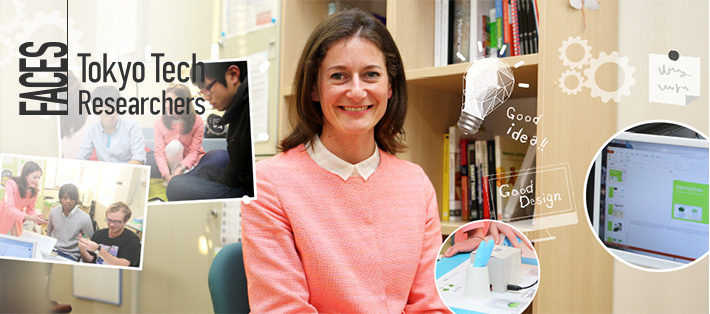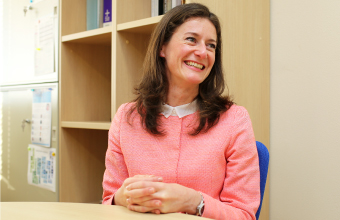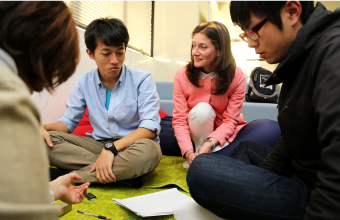
Issue 12
Associate ProfessorCéline Mougenot
Department of Mechanical Engineering Graduate, School of Engineeringy
A field that studies user experience
What is your main area of research?
The name of the field is engineering design. My background is actually in product design and mechanical engineering. Mechanical engineering is about designing machines and systems, while engineering design focuses on people's experience with machines and systems. In engineering design, we care about not only technology itself, but also how people interface with technology.

What is unique about your lab?
My lab is part of the mechanical engineering department, but we conduct research on how people use technology. We focus on people as much as we do technology and care about how people use products that have been designed by engineers. When engineers design products, they mostly care about functionality, but in our lab, we are especially interested in people's experience, including emotional experience, with using products. There are two important sides to product design: one is functionality, which is about engineering, and the other is emotion, which is about how people interact with products. My lab is unique in that we care about the feelings that people experience when using technologies.
Is that what affective engineering is about?
Exactly. Affective engineering originated in Japan and has spread all over the world. Affective engineering is about how to measure emotional reactions and how to apply these measurements in the design process. It's about understanding what people feel when they interact with products and using this data to improve design.
How did you become interested in affective engineering?
I was trained as a mechanical engineer, and I worked for a computer-aided design software company for four years after getting my first master's degree. When I was working for this company, I noticed that most engineers focused on designing nice technologies but didn't care as much about how people would use them. Maybe it's the human part in me that felt that something was missing. Today, products such as smartphones are very successful because people enjoy using them. So what's important is not just the technologies inside products, but also the enjoyment that products offer.
Innovating the future of design

Do you have a vision of how your field will develop in the future?
In my lab, we are trying to merge two innovative research fields - affective engineering and interaction design. Interaction design is about how people use their brains, bodies and senses to interact with products. For example, when using smartphones, people use swiping gestures, which makes the use of their phones intuitive and enjoyable. We're interested in designing interesting interactions for users and bringing more sensory qualities to products. We have several projects in the lab for designing new communication devices and are trying to imagine futuristic ways of communicating. For example, we have a team of students that is designing a device that expresses people's moods. The device has an input and an output component. If you touch the input component softly, the output component will move gently; if you grab the input component aggressively, the output component will vibrate accordingly.
Today, we tend to dematerialize many things. For example, hand-written letters have been replaced by emails. This limits the use of our bodies and senses. With typed text, all messages look and feel the same. I believe that affective engineering and interaction design will contribute to the development of devices that involve our bodies and senses to a greater extent, and thus will lead to greater enjoyment for product users.
How does the scientific study of design benefit society?
The scientific study of design will lead to new methods for design - such as methods used in testing users and collecting data in order to improve design. These studies will lead to better products in terms of usability and pleasure. The first scholar who studied design scientifically was Herbert Simon in the United States. In 1969, he published a book called The Sciences of the Artificial. Design is part of everything around us that is artificial - furniture, computers, and even the building that we're in. Anything that is designed can be improved by the scientific study of design.
Design is Multidisciplinary

Design is not simply a matter of aesthetics. Mougenot explains that design is a combination of various disciplines. For example, engineering is necessary for creating new products, but human sciences is also necessary for understanding how people perceive products. Affective engineering captures the multifaceted nature of design and offers an approach to creating designs that are both functional and emotionally appealing.
Looking at Tokyo from the point of view of design

What brought you to Japan?
My first visit to Japan was back in 2005 when I spent my summer vacation working as a research intern. My professor, who had studied in Japan for a few years, recommended me to go overseas to expand my horizons, and that was the only reason I came to Japan. I did not have any special attachment to Japan at that time. However, my second visit was a bit different. This was when I applied to the University of Tokyo as a postdoctoral fellow. This time I realized that Japan has an appealing culture. Tokyo is a really big city with many interesting cultural activities, and at the same time, it's safe, quiet, and clean. I ride my bicycle a lot in Tokyo, whereas in Paris, it is much more difficult to get around by bicycle. I enjoy the quality of life in Tokyo.
From the point of view of design, the ways in which cities can be used is just as important as their appearance. Tokyo may be better designed than Paris in terms of how people are able to access and use what the city offers, such as the transportation system. Also, in Japan there are many products with amusing design such as toilets fitted with pressurized water sprayers and warm seats. These products are useful and pleasant to use - a perfect design if you ask me!

What are the advantages of pursuing your research at Tokyo Tech?
I think I joined Tokyo Tech at a very good time because there are many things in education and research that are related to design. For example, in our department, we are creating a design space with several faculty members where people can gather for design projects and conduct design activities such as brainstorming, prototyping, and user testing. Also, Tokyo Tech attracts students from many different countries, so there is diversity here. Diversity helps foster creativity, as I can observe in my lab where students come from six different countries. This is a very exciting time to be at Tokyo Tech, both for faculty and students.
What message would you like to give to Tokyo Tech students?
I would encourage everyone to go abroad and interact with international students. Traveling and meeting new people will enhance your creativity, which will make you a better engineer.

Céline Mougenot
Profile
- 2011Associate Professor, Department of Mechanical Engineering, Graduate School of Engineering, Tokyo Institute of Technology
- 2009Research Associate (JSPS Research Fellow), University of Tokyo
- 2008Doctor of Engineering, Arts et Metiers ParisTech
- 2005Master of Industrial and Product Design, Universite de Technologie de Compiegne
- 2001Dassault Systemes (to 2005)
- 2001Master of Mechanical Engineering, Institut National des Sciences Appliquees (INSA Lyon)
The Special Topics component of the Tokyo Tech Website shines a spotlight on recent developments in research and education, achievements of its community members, and special events and news from the Institute.
Past features can be viewed in the Special Topics Gallery.
. Any information published on this site will be valid in relation to Science Tokyo.











